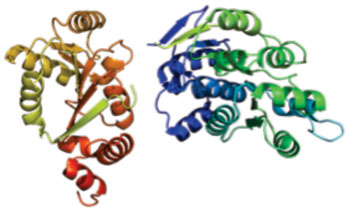Experimental Drug Blocks Critical Lung Cancer DNA Repair Enzyme
By LabMedica International staff writers
Posted on 03 Jun 2015
A low molecular weight drug—effective on its own and in combination with radiation therapy—has been developed that interferes specifically with the cell cycle of lung cancer cells.Posted on 03 Jun 2015
The drug, RK-33, was developed by investigators at Johns Hopkins University (Baltimore, MD, USA) to block the activity of the RNA helicase, DDX3 (DEAD (Asp-Glu-Ala-Asp) box helicase 3, X-linked), which is overexpressed in many cancer types including lung cancer and is associated with lower survival in lung cancer patients.

Image: Structure of the DDX3X protein (Photo courtesy of Wikimedia Commons).
The main function of helicases is to unpackage an organism's genes. They are motor proteins that move directionally along a nucleic acid phosphodiester backbone, separating two annealed nucleic acid strands (i.e., DNA, RNA, or RNA-DNA hybrid) using energy derived from ATP hydrolysis. There are many helicases due to the great variety of processes in which strand separation must be catalyzed. The human genome codes for 95 non-redundant helicases: 64 RNA helicases and 31 DNA helicases.
DDX3 is a member of the large DEAD-box protein family, which is defined by the presence of the conserved Asp-Glu-Ala-Asp (DEAD) motif, and has ATP-dependent RNA helicase activity. This protein has been reported to display a high level of RNA-independent ATPase activity, and unlike most DEAD-box helicases, the ATPase activity is thought to be stimulated by both RNA and DNA. This protein has multiple conserved domains and is thought to play roles in both the nucleus and cytoplasm. Overexpression of this gene has been implicated in tumor development.
The investigators synthesized the low molecular weight compound RK-33, which was designed to inhibit DDX3 by binding to the nucleotide-binding site within the enzyme. Results published in the May 2015 issue of the journal EMBO Molecular Medicine revealed that RK-33 binding inhibited DDX3's DNA repair function, which caused tumor cells to die and increased the efficacy of radiation therapy. RK-33 in combination with radiation induced tumor regression in multiple mouse models of lung cancer without causing damage to noncancerous tissues.
“We can lower the dose of radiation significantly but actually get more “bang for your buck” by pretreating lung cancer with RK-33,” said senior author Dr. Venu Raman, associate professor of radiology, radiological science, and oncology at Johns Hopkins University. “DDX3 is an extremely novel target associated with many cancer types and perturbing its function with a small molecule will enhance efficacy for cancer treatment. It is hard to find a magic bullet for cancer treatment, but because RK-33 is nontoxic and is a phenomenal radiosensitizer, there are so many opportunities.”
Related Links:
Johns Hopkins University










 (3) (1).png)


